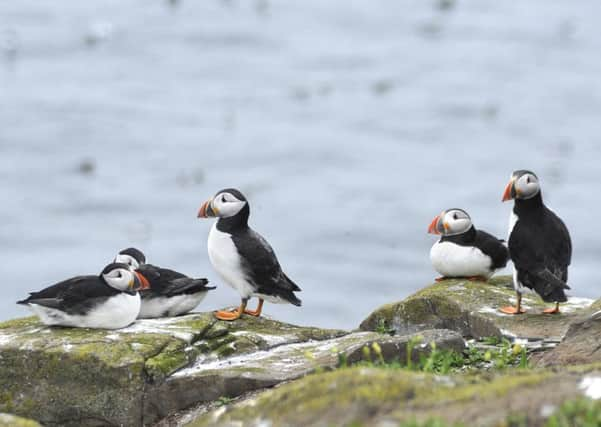Alarming dive in Farnes puffin numbers


Initial numbers suggest the population has fallen by up to 42 per cent on one of the islands – much worse than expected since the last count in 2013, when nearly 40,000 breeding pairs were recorded.
And there is real concern that the Farnes’ puffin population will have completely died out in 50 to 100 years.
Advertisement
Hide AdAdvertisement
Hide AdThe Trust, which has been looking after the islands for 93 years, will step up monitoring in a bid to help better understand the alarming decline.
The puffins have also returned four weeks later than usual to their nesting grounds on the windswept islands off the Northumberland coast, due to the prolonged harsh winter.
Ranger Tom Hendry said: “Initial findings are concerning. Numbers could be down due to stormy or wetter weather as well as changes in the sand eel population, which is one of their staple foods.
“So far we’ve surveyed four of the eight islands where we conduct the census. Figures from the two largest islands are vastly contradictory with numbers on Brownsman 42 per cent down, while recordings on Staple show an 18 per cent increase. We will now do some further investigations as to why this might be.
Advertisement
Hide AdAdvertisement
Hide Ad“Figures across the two smaller islands are more consistent, but numbers are still down by up to 33 per cent. We will hopefully have a much clearer picture towards the end of the count in late June.
“If the final results reflect this drop, this will increase the need for us to monitor these birds more frequently.”
The Atlantic puffin was given vulnerable status in 2015 by the International Union for the Conservation of Nature when worldwide numbers dropped.
The most likely contributors to this decline internationally include climate change contributing to food shortages and extreme weather, overfishing, invasive predators such as rats on some islands and marine pollution, in addition to other threats.
Advertisement
Hide AdAdvertisement
Hide AdThe puffin is also on the British Trust for Ornithology’s Red List for species of conservation concern in the UK.
Puffin records on the Farne Islands date back to 1939, when just 3,000 breeding pairs were recorded. Every census until 2008 showed a steady increase in pairs of puffins – but in that year, numbers fell by a third, falling from 55,674 to 36,835.
Again, this drop was thought to be largely due to the impacts of climate change.
The last census in 2013 revealed there were 39,962 breeding pairs on the island.
Advertisement
Hide AdAdvertisement
Hide AdPuffins have traditionally done well on the Farnes due to the rangers’ protection of the birds, good sources of food, a lack of ground predators and the availability of suitable nesting areas.
But Tom said: “Predictions have been made that within the next 50 to 100 years these stunning birds will have completely died out on the Farne Islands. The Icelandic population in particular is really struggling, with exceptionally low productivity for more than 10 years. The monitoring of puffin numbers worldwide is therefore really important to discover whether the species can continue to survive.
“If the causes of puffin decline are what we suspect, it will require a bigger effort to encourage everyone to think about how we can prevent overfishing, reduce our use of single-use plastics and limit our use of non-renewable energy, but it can be done.”
This year marks the 25th anniversary of the Farnes achieving National Nature Reserve status. The census results will be announced in October.